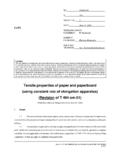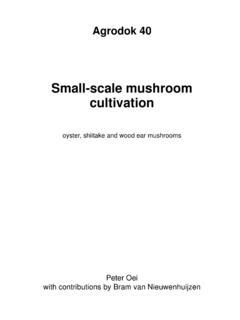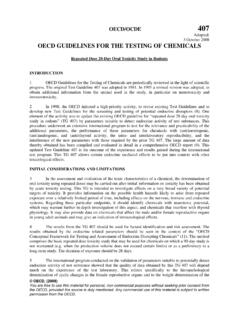Transcription of Guide to Understanding Condensation - C&L Ward
1 The complete Andersen Owner-To-Owner limited warranty is available at: Andersen is a registered trademark of Andersen other marks where denoted are marks of Andersen Corporation. 2007 Andersen Corporation. All rights reser ved. 7/07 Guide to Understanding CondensationINTRODUCTIONThe moisture that suddenly appears in cold weather on the interioror exterior of window and patio door glass can block the view, dripon the floor or freeze on the glass. It can be an annoying it may seem natural to blame the windows or doors, interiorcondensation is really an indication of excess humidity in the Condensation , on the other hand, is a form of dew theglass simply provides a surface on which the moisture can important thing to realize is that if excessive humidity iscausing window Condensation , it may also be causing problemselsewhere in your home.
2 Here are some other signs of excesshumidity: A damp feeling in the home. Staining or discoloration of interior surfaces. Mold or mildew on surfaces or a musty smell. Warped wooden surfaces. Cracking, peeling or blistering interior or exterior paint. Sweating pipes. We have created this brochure to answer questions you may haveabout Condensation , indoor humidity and exterior Condensation . We ll start with the basics and offer solutions and alternatives along the way. Should you run into problems or situations not covered in thefollowing pages, please contact your Andersen the Andersen website: The Andersen customer service toll-free number: causes Condensation ?
3 When warm, moist air comes into contact with cooler surfaces, the excess moisture in the air condenses. That s because the cooled air next to the cool surface can t hold as much moisture as the warmer surrounding does the Condensation on windows mean?Window Condensation can be a warning sign. It may mean that excessive indoorhumidity could be doing unseen damage to other parts of your is humidity ? humidity is water vapor, or moisture, in the air. Usually it s invisible. In the form of steam or ground fog, enough has condensed to be seen.
4 All air contains a certain amount of moisture, visible or does indoor moisture come from?There are many things that generate indoor moisture. The normal perspiration and breathing of a family of four adds about half a pint of water to the air every hour. Cookingthree meals a day adds four or five pints of water to the air. Each shower contributesanother half-pint. In fact, every activity that uses water (like dishwashing, mopping floors,doing laundry) adds moisture to the air. Daily living activities of a family of four can addmore than 18 gallons of water a week to the air in their home.
5 And the more water vaporin the air, the higher the relative indoor humidity . Other contributors include house plants,and the burning of fossil fuels (especially kerosene, natural gas, and oil).What is relative humidity ?Air can hold only a limited amount of water vapor, and that amount dependson the air temperature. When air at a certain temperature contains all the vaporit can hold, it s said to have a relative humidityof 100%. Thus, whenit holds only half as much water as it could, the relative humidity is 50%.
6 Cooler air can hold less vapor than warmer air. So air at 30 F and 100% relative humidity contains less water than air at 70 F and 100% relative do I measure indoor relative humidity ?You can use humidity -measuring instruments called hygrometers, inexpensivetools that can be purchased at most hardware stores. Many of today s new programmable thermostats also include controls for humidifiers and that relative humidity levels quoted in weather reports indicate outdoorhumidity. They have little bearing on your home s are symptoms of excess humidity ?
7 Condensation on windows can sometimes be an indicator of excessive relativehumidity. Look for water and ice on windows. Check for damp spots on the ceiling, particularly in closets. Water-filled blisters on outside paint surfaces can also indicate excessive indoor is Condensation ?Moisture on the windows is a form of Condensation . So is the water that formson the outside of a glass of iced tea in the summer. It comes from water vaporin the air. It can appear on the interior or exterior of the window ANDHUMIDITYCan relative humidity affect my health?
8 Most experts agree that relative humidity can affect your health. They suggestmaintaining indoor humidity levels between 30% and 50%. According to theWorld Health Organization, at levels higher than 65%, upper respiratory illnessmight occur in people suffering from asthma and allergies. Lower moisture levels (below 20%) may induce skin dryness or is Condensation most prevalent? Condensation is more apt to occur in climates where the average January temperature is 35 F or does excess humidity do to my home?
9 Excess humidity contributes to the deterioration of any home. It can pass throughwalls and freeze in the insulation. In spring it melts, damaging your ceiling andwalls. Or, excess humidity can force its way out through siding to form blistersunder exterior surfaces. Excessive relative humidity levels may also lead to higherlevels of unwanted mold and mildew growth in does moisture go through walls?Moisture in wet air tries to flow toward dry air. This is due to vapor pressure. The flow acts independently of air currents.
10 In winter, inside air is much morehumid than colder outside air. So the vapor pressure, or equalization process,can actually force inside moisture through cement, wood, plaster and varnishes and paints block the flow of the moisture, so Condensation canoccur between the inside and outside walls, or under exterior paint can cause rot in a home s wood frame, blistering in paint, and deteriorationof other building Condensation occur only in winter? Condensation is most common in winter, but it can occur whenever water vapor in the air comes in contact with a surface temperature lower than the dew point (the temperature at which air becomes saturated and produces dew).






